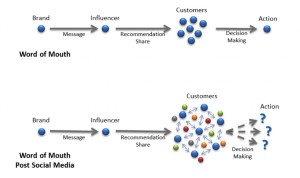By: LOUISE MARSLAND
Influencer marketing has seen explosive growth in the last couple of years and is becoming a dominant practice in marketing communications.
Influencer marketing is defined as that form of marketing that uses individuals with influence over potential customers or groups of customers. Social media has amplified the reach of such influencers and as we all know, shifted the balance of power from brands to the customer in just a few short years.
And this is not about celebrities or obvious bloggers anymore, but ordinary people out there who command a platform and have a voice that holds sway over thousands or have the kind of expert knowledge that will give them a trusted profile and credibility. Much of the profile of these modern day influencers have been driven by social platforms like Instagram, YouTube and Forbes and gives the now world famous example of young beauty blogger Michelle Phan, who started filming simple make up tutorials for teen girls and garnered over 7.5 million followers, leading to major brand sponsorship and her own cosmetic line with L’Oreal!
I love this quote by Forbes contributor Kyle Wong: “The voice of the customer has always been one of the most powerful concepts in marketing, and today’s social media platforms act as one giant megaphone for that voice.”
Influencer marketing doesn’t discount the influence of individuals and ordinary peer-based networks and savvy brands need to take these into account. For example, I belong to a mom’s group online of almost 4,000 members in the geographic area I live in and apart from helping the community of young moms with parenting and child care advice and buying and selling used children’s equipment, furniture, toys and clothing; the moms also punt their own businesses; do charity work; and, most importantly, air their views on good and bad brands and service – giving advice daily on the best doctors, handymen, plumbers, electricians, mechanics, builders, retailers, sales… everything from local crime warnings to traffic reports, lost pets, nearby holiday destinations that are kid and pet friendly and advice on breast feeding, odd rashes on their kids and even contraceptive advice.
I have alerts set up for the moms’ site as it is my most important resource in keeping tabs on what is happening in my own community. And I don’t hire anyone in my valley or patronise a local business I don’t know, without getting a recommendation from another mom first. And it’s the place I get my most accurate load shedding alerts too! During the recent Cape fires, it was also the central rallying point for donations to the fire stations and other evacuation points in my area. It is all word-of mouth and peer-led, no advertising allowed by brands or outsiders. Absolute word-of-mouth – for brands to be featured, they simply have to provide great service to the moms who patronise them in our area. Savvy brands should being going out of their way to tap into this community. Not many do yet. There is a kind of social currency to highlighting good – and bad – service and making recommendations to your fellow moms. There’s even been a print brochure published of top service providers as recommended by the moms, for free distribution in the broader community.
Research
In the latest research into influencer marketing released three days ago, Social Media Examiner says marketing budgets globally for influencer marketing are increasing as the buzz intensifies. Research has also found that younger audiences trust social media stars over movie or TV stars, because that is where they are consuming their media.
Convinceandconvert.com even explains how the ‘Four Ps’ of marketing (Product, Price, Promotion, Place) have evolved into the ‘Four Ms of Influence Marketing’: Make, Manage, Monitor, Measure, to create a “defined path for marketing success in social media”. Lovely graphics, too.
As always, there are stats and research to back up the story, too:
• McKinsey found that marketing-inspired word-of-mouth generated twice the sales of paid advertising.
• Word-of-mouth customers had a 37% higher retention rate.
• A driver of influencer marketing is the “fragmentation” of customer attention across various digital channels: “The emergence of new influencer verticals/talent will allow brands to execute more targeted campaigns” (Source: Bertelsmann Digital Media Investments).
• Authenticity is key as well as, obviously, having a great product or service. But trust is still key and a trusted recommendation from a friend or someone in your network has more credibility than advertising, according to Marketing-Schools.org.
So, how should brands leverage influencers? Brands have to know their customers and provide a superior customer experience to generate the unsolicited commentary people post to social media. South African agency, Cerebra, this week published its free, downloadable report on Influencer Marketing, entitled ‘Influence for sale’, highlighting the following for marketers:
1. Brand messages must be delivered authentically.
2. An influencer should be equally invested in the brand message.
3. The ‘sweet spot’ is that the influence not only appears genuine, but is. Credibility is everything.
4. Influencer marketing cannot simply be used to sell – influencers should “never be seen as walking, tweeting billboards”, but as partners.
5. The key question is: ‘How do you build relationships with influencers that really make sense’; not ‘How can influence be bought’.





 360 Market Solutions Ltd is a customer focused experiential marketing agency. Incorporated in 2014, we are primarily involved in the delivery of enhanced brand, customer and consumer experience to our client. As an agency, we are committed to administering tailored and best fit strategies in the delivery of our service.
360 Market Solutions Ltd is a customer focused experiential marketing agency. Incorporated in 2014, we are primarily involved in the delivery of enhanced brand, customer and consumer experience to our client. As an agency, we are committed to administering tailored and best fit strategies in the delivery of our service.